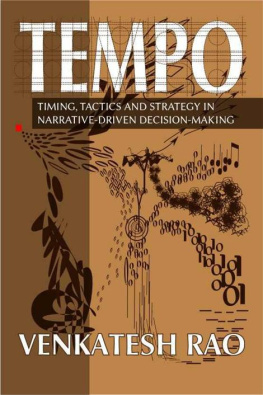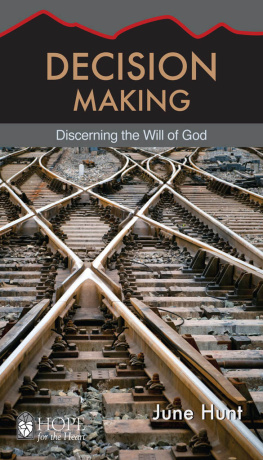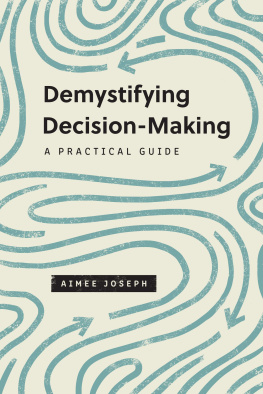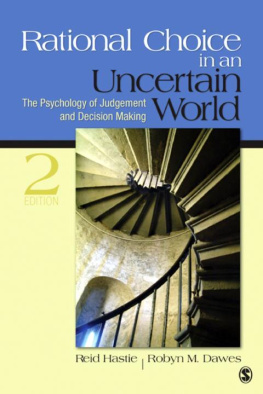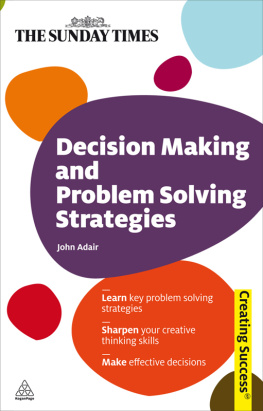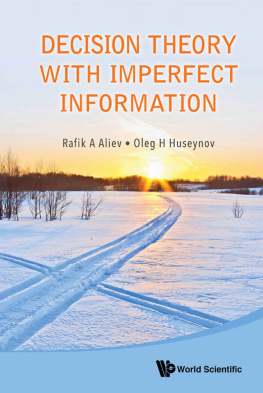Ribbonfarm, Inc.
2011 by Ribbonfarm, Inc. All rights reserved
ISBN: 978-0-9827030-1-4
Digital book(s) (epub and mobi) produced by: Kimberly A. Hitchens,
For Wilbur, a high-tempo cat.
2007 - 2008.
Lonely one, you are going the way to yourself. And your way leads past yourself and your seven devils. You will be a heretic to yourself and a witch and soothsayer and fool and doubter and unholy one and a villain. You must wish to consume yourself in your own flame: how could you wish to become new unless you had first become ashes!
Lonely one, you are going the way of the creator: you would create a god for yourself out of your seven devils.
Preface
Cooking was my unwinding ritual during the many leisurely years I spent studying the decision sciences, first as a graduate student at the University of Michigan and then as a postdoctoral researcher at Cornell. This book originally started and I am being completely serious here -as an idea for a cookbook. Heres the story of how it came to be a book about decision-making.
My time at Cornell, between 2004 and 2006, was ridiculously idyllic. For a good part of that period, I lived a rather monastic life in an isolated apartment complex near the Buttermilk Falls state park, in the hills outside Ithaca. Not quite Thoreaus Walden Pond, but close. Every evening, Id drive back from my office on campus past several of Ithacas famous waterfalls. Whether the day had been frustrating or rewarding, the sight of the waterfalls would always return me to equilibrium. Soon after I settled into this routine, I noticed that dinners started in this state of waterfall-induced equilibrium seemed to turn out better. And so it was that my times in the kitchen turned into episodes of idle wondering, as I chopped and stirred, about the role of waterfalls and other subtle ingredients in cooking.
My memories of Ithaca revolve around these solitary episodes in the kitchen. I had plenty of time to ponder the broad question of how cooks make decisions in kitchens, ranging from what can I make with whats in my fridge? to is it time to flip this pancake? Out of these episodes was born an idea for a book on improvisational cooking, and the rhythms and cadences of the kitchen.
But as I gathered my thoughts and began making my notes, I realized that as a cook, I was at best an enthusiastic amateur. What I really wanted to do, it became clear, was write about the interplay of rhythms, emotions and energy in decision-making that is so vividly evident in cooking. The kitchen was just a particularly rich metaphor for a broader theme.
So I started assembling the ideas into a broader synthesis, and began noticing and collecting questions, ideas and examples from other domains. It seemed to me that the rich interplay of rhythms, emotions and energy was everywhere I looked:
- How was I making the apparently trivial decision of when to flip a pancake, against the backdrop of impatience, hunger, wrist-skill, and flame control?
- How, by focusing on my stroke and breathing, rather than my strength, was my swim coach able to lower my sprint times and the amount of energy I spent?
- How do musicians performing jam sessions decide what to play next?
- How do good managers steer a meeting?
This was a complex set of questions, and I found myself groping for that key insight, that high-concept which would miraculously dissolve the complexity. The answer began to emerge from the research I was involved in at the time, on command and control.
My research, funded by the US Air Force, concerned what are called mixed-initiative command and control models: complex systems where humans, autonomous robotic combat vehicles and software systems share decision-making authority.
Somewhere in my reading, I stumbled across the idea that one must control the tempo of a military engagement. Shock-and-awe is an example of tempo-driven war-making.
The idea, and in particular, the word tempo, stuck in my mind as clever and evocative. But at the time, I didnt pay much attention; it seemed like no more than a clever motif. It would take me nearly four more years, including two immersed in the decidedly non-monastic world of business, before I recognized the idea of tempo for what it was: the high concept I was looking for, to organize my messy thoughts on decision-making that began in the kitchen.
I first attempted a synthesis towards the end of my postdoctoral stint with Raff DAndreas group at Cornell. In 2006, I designed and taught a graduate course on the decision sciences, in collaboration with my doctoral advisor Pierre Kabamba, who taught the course in parallel at the University of Michigan. Among the workshop exercises I devised for the course were a challenge to model call-and-response drumming, and at least one example involving the kitchen. It was a lot of fun.
Yet, despite the fun, the course had a discursive, grab-bag feel to it. One of the smartest students in the class (and a key architect of the world-beating Cornell robotic soccer team that Raff managed at the time) commented, I like the material, but I dont yet see the thin red line connecting all the ideas.
He was right. I was missing certain powerful ideas about metaphor and narrative in human decision-making that had been evolving in the humanities since the 1970s. When I left Cornell and joined Xerox in 2006, I had an opportunity to dive into those subjects. At Xerox, I encountered the fascinating world of collective, real-time business decisionmaking. At the same time, I started my blog, ribbonfarm, which allowed me to tackle the ideas from the humanities that Id encountered, but not explored in depth, during my university years.
And one fine day, in the summer of 2008, I realized that Tempo was the title of a book demanding to be written. A book that would weave the tragic passion of the humanities together with the unsentimental austerity of the mathematical decision sciences, to tell you the story of your life.
The ideas in this book were inspired by questions from everyday life at work, home and play. I have tried to return to those worlds, and frame what I have to say as deeper insights into common sense. But this has not always been possible. Ideas from dusty academic journals and from rarefied domains of practice such as boardrooms and the decks of aircraft carriers are not always reducible to everyday experience. So yes, at times, you will need to stretch your mind.
But you should expect and even welcome the challenge. You live in a complicated world, where you must contend with globe-spanning human decision processes that affect your life. Everything you need to know, you did not learn in kindergarten.
Welcome to Tempo.
Chapter 1
Introduction
Does the road wind up-hill all the way?
Yes, to the very end.
Will the days journey take the whole long day?
From morn to night, my friend.
From Up-Hill by Christina Rossetti
Decisions punctuate our thoughts and actions and set the pace of our lives. They drive, and are in turn driven by, energy and emotional experience the ebb and flow of anxiety, lethargy, excitement and impatience and lend to our experience of time a choppy, emotionally charged tempo. This notion of tempo is the central concept we will use to organize this book about decision-making. There are many excellent reasons to look at decision-making from this perspective, but perhaps the best reason is that it is somewhat unsettling. My objective in this book is to get you to look at the familiar with new eyes.

